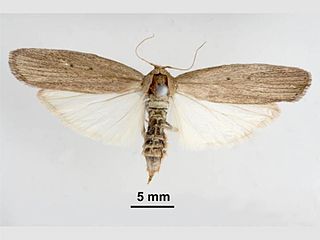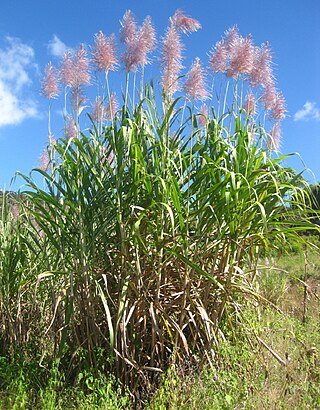
Sugar is the generic name for sweet-tasting, soluble carbohydrates, many of which are used in food. Simple sugars, also called monosaccharides, include glucose, fructose, and galactose. Compound sugars, also called disaccharides or double sugars, are molecules made of two bonded monosaccharides; common examples are sucrose, lactose, and maltose. White sugar is a refined form of sucrose. In the body, compound sugars are hydrolysed into simple sugars.

Bagasse is the dry pulpy fibrous material that remains after crushing sugarcane or sorghum stalks to extract their juice. It is used as a biofuel for the production of heat, energy, and electricity, and in the manufacture of pulp and building materials. Agave bagasse is similar, but is the material remnants after extracting blue agave sap.

The blond capuchin is a species of capuchin monkey endemic to northeastern Brazil. This endangered species was rediscovered in 2006. It can live in exceptionally large groups of over 150 individuals, and like other capuchin species, exhibits a complex and high level of sociality. It is threatened by loss of habitat due to agriculture, primarily sugarcane fields. In many cases this has caused sugarcane to make up a large portion of their diet, which would otherwise consist of mostly fruit and small animals. The blond capuchin is known to inhabit both the Atlantic forest and Caatinga biomes, although the habitation of the Caatinga may be a recent choice caused by human encroachment into its former habitats. Like other primate species, the blond capuchin is also threatened by poaching and capture for the illegal pet trade.

Charanda is an alcoholic spirit derived from sugarcane, similar to rum.

Leptosphaeria sacchari is a plant pathogenic fungus which causes a disease called ring spot on Saccharum officinarum. This species was originally described in 1890 by Kruger and in 1892 by Van Breda de Haan after it was discovered in the Dominican Republic. L. sacchari is the applied name, whereas Epicoccum sorghinum is the accepted name.
Peronosclerospora sacchari is a plant pathogen, particularly for maize and sugarcane. It is closely related to Peronosclerospora philippinensis.
Glomerella tucumanensis is a species of fungus in the family Glomerellaceae. It is a pathogen of sugarcane responsible for the disease known as red rot of sugarcane, this disease impacts sugarcane production in South and South-East Asia and has spread to 69 countries. It has been responsible for the elimination of many commercial varieties of sugarcane.
Federal Route 79, or Jalan Ulu Pauh–Padang Besar, is a federal road in Perlis, Malaysia. The 28.5 km road connects Padang Besar in the north to Ulu Pauh in the south.

Sugarcane mosaic virus (SCMV) is a plant pathogenic virus of the family Potyviridae. The virus was first noticed in Puerto Rico in 1916 and spread rapidly throughout the southern United States in the early 1920s. SCMV is of great concern because of the high economic impact it has on sugarcane and maize.

Sugarcane or sugar cane is a species of tall, perennial grass that is used for sugar production. The plants are 2–6 m (6–20 ft) tall with stout, jointed, fibrous stalks that are rich in sucrose, which accumulates in the stalk internodes. Sugarcanes belong to the grass family, Poaceae, an economically important flowering plant family that includes maize, wheat, rice, and sorghum, and many forage crops. It is native to the warm temperate and tropical regions of India, Southeast Asia, and New Guinea. Grown in tropical and subtropical regions, sugarcane is the world's largest crop by production quantity, totaling 1.9 billion tonnes in 2020, with Brazil accounting for 40% of the world total. Sugarcane accounts for 79% of sugar produced globally. About 70% of the sugar produced comes from Saccharum officinarum and its hybrids. All sugarcane species can interbreed, and the major commercial cultivars are complex hybrids.

Sugarcane grassy shoot disease (SCGS), is associated with 'Candidatus Phytoplasma sacchari' which are small, pleomorphic, pathogenic mycoplasma that contribute to yield losses from 5% up to 20% in sugarcane. These losses are higher in the ratoon crop. A higher incidence of SCGS has been recorded in some parts of Southeast Asia and India, resulting in 100% loss in cane yield and sugar production.
Lokur is a village in Kagwad tehsil, Belgaum district, in the state of Karnataka, India. According to Census 2011 information the location code or village code of Lokur village is 597287. It is 32 kilometres (20 mi) from the sub-district headquarters at Athni and 122 kilometres (76 mi) from the district headquarters at Belgaum. As per 2009 stats, Mangasuli is the gram panchayat of Lokur village.
Mahishwadgi is a village in Belgaum district of Karnataka, India. Mahishwadgi is situated on the banks of Krishna River, 25 km from Athani, Belgavi. 90% of the population follow Jainism.
Malikwad is a village which is located in the Belgaum district of Karnataka state, India. It is located on the banks of the Doodhganga River. The river acts as the border between Karnataka and Maharashtra. Due to the border separation, the people in the area are bilingual; many can speak as well as write both Kannada and Marathi languages. Facilities in the village include schools, a library, and public toilets. Agriculture is a mainstream source of income of the village. It is regarded as one of the highest sugarcane producing villages. Along with sugarcane, farmers also grow different kinds of fruits and vegetables such as tomatoes and bananas. Almost one member of every family in the area is in the Indian army, so people have called this village “Sainik Malikwad,” the word “sainik” meaning “soldier.”

Eldana is a genus of moths of the family Pyralidae containing only one species, the African sugar-cane borer, which is commonly found in Equatorial Guinea, Ghana, Mozambique, Sierra Leone and South Africa. Adults have pale brown forewings with two small spots in the centre and light brown hindwings, and they have a wingspan of 35mm. This species is particularly relevant to humans because the larvae are a pest of the Saccharum species as well as several grain crops such as sorghum and maize. Other recorded host plants are cassava, rice and Cyperus species. When attacking these crops, E. saccharina bores into the stems of their host plant, causing severe damage to the crop. This behavior is the origin of the E. saccharrina's common name, the African sugar-cane borer. The African sugar-cane borer is a resilient pest, as it can survive crop burnings. Other methods such as intercropping and parasitic wasps have been employed to prevent further damage to crops.

Edavalath Kakkat Janaki Ammal was an Indian botanist who worked on plant breeding, cytogenetics and phytogeography. Her most notable work involved studies on sugarcane and the eggplant (brinjal). She also worked on the cytogenetics of a range of plants and co-authored the Chromosome Atlas of Cultivated Plants (1945) with C.D. Darlington. She took an interest in ethnobotany and plants of medicinal and economic value from the rain forests of Kerala, India. She was awarded Padma Shri by the then prime minister of India in 1977.

Saccharum officinarum is a large, strong-growing species of grass in the sugarcane genus. Its stout stalks are rich in sucrose, a simple sugar which accumulates in the stalk internodes. It originated in New Guinea, and is now cultivated in tropical and subtropical countries worldwide for the production of sugar, ethanol and other products.
Kishan Singh was an Indian plant pathologist, known for his contributions to the pathology of crops, especially sugarcane. An alumnus of the Chandra Shekhar Azad University of Agriculture and Technology, he is reported to have done seminal research on the epidemiology and control of sugarcane diseases and suggested disease management through hot air therapy. He has published his research findings by way of articles and books, which include Soil fungicides, Recent advances in plant pathology, The national research grid for sugarcane in India, Sugarcane diseases and prospects of their control, Diseases of sugarbeet in India, Grassy shoot disease of sugarcane : III: response of varieties to infection, Innovations in companion cropping with sugarcane and Laminar infection of sugarcane leaves by red rot organism in nature. The Council of Scientific and Industrial Research, the apex agency of the Government of India for scientific research, awarded him the Shanti Swarup Bhatnagar Prize for Science and Technology, one of the highest Indian science awards, in 1976, for his contributions to biological sciences. Singh died on 2 September 2012, at the age of 81.

The first sugar mill in India was established in the year 1903 in Pratappur area of Deoria district.
Chinna rasalu or Chinnarasamulu is an Indian mango variety originating in Nuzvid, Andhra Pradesh, India. It is a particularly juicy variety and it is grown across Andhra Pradesh and Telangana in Southern India.Cheruku rasalu is the bigger version of chinna rasalu it is sweet as sugarcane. sugarcane is called as cheruku in telugu so it is named as cheruku rasalu











